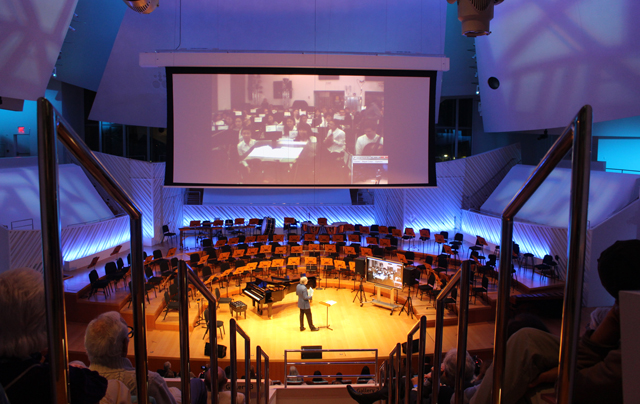
A musical collaboration, across the miles
Michael Tilson Thomas workshops with the Atlanta Symphony Youth Orchestra via Internet2 in NWS’ 2015 Town Hall Master Class and Side-by-Side Concert. Photo courtesy of New World Symphony.
The future was on display during a remarkable evening of music, education and technology at the New World Center in Miami Beach Wednesday night. RELATED LINKS
“Musaic, a musical meeting house for the world” on Knight Blog, by Fernando Gonzalez
Titled a “Town Hall Master Class and Side-by-Side Concert,” the annual event, part public workshop-demonstration, part concert, brought together this year the New World Symphony and students from middle and high schools in South Florida and beyond.
It featured Michael Tilson Thomas, co-founder and artistic director of the New World Symphony; marimba player Charles Comiter, from the A.W. Dreyfoos School of the Arts in West Palm Beach; clarinetists Daniel Bermúdez Tamayo, a student at the Academia Filarmónica de Medellín, Colombia; New World Symphony fellows; and music students from Medellín; members of the Metropolitan Youth Symphony in Portland, Ore.; and students from South Florida. The young musicians from Medellin and Portland were participants in New World’s long-distance teaching programs. The South Florida players had auditioned for the Side-by-Side concert and, as part of the experience, were able to spend time, virtually and in person, working with New World fellows.
But perhaps the evening’s most memorable moment was the collaboration brought about by technology, as Tilson Thomas, on stage at the New World Center in Miami Beach, conducted the Atlanta Symphony Youth Orchestra, set in a room at Georgia Tech University in Atlanta, using Internet2 and LOLA, or low-latency, a software that reduces the delay in the streaming of audio and video.
Knight Foundation has been a longtime supporter of New World Symphony’s exploration and use of digital technologies for both teaching and performance. In 2008, New World received $5 million to create the Knight New Media Endowment.
In fact, New World Symphony has been using this technology for conferences, coaching online and long-distance teaching, but this was the first time it was used in a public performance.
“The challenge here is that the signal has to get there and has to come back and it’s much easier to send sound than visual because there is so much information in a signal,” explained Tilson Thomas from the stage, standing before a large flat screen equipped with a camera. A large screen was rolled down showing the image of the Atlanta Symphony Youth Orchestra to the audience.
“The goal with this connection is to stay under this 40 millisecond threshold that has been identified in practice as the point beyond which the delay prevents playing in time with each other,” explained Justin Trieger, New World’s director of distance education, the day before the concert. “What’s particularly challenging with the conducting scenario is that it’s almost completely reliant on the visual side of it for cueing and maintaining tempos and that kind of thing … so we really had to continue to work to minimize the delay to make it feel natural.”
Wednesday, Tilson Thomas noted that the delay had been reduced to “about 14 milliseconds.”
“That’s seven milliseconds for our video and audio to get there, and seven to come back. There‘s about another 15 milliseconds to reach the monitor and the speakers. So the grand total is between 22 and 30 milliseconds for the Atlanta Symphony Youth Orchestra to see us and react,” he said. “I’ve been told that each millisecond equals about one foot of physical distance, so it’s as if we were about 20 feet from the orchestra as opposed to the actual distance to Atlanta. [About 600 miles]”
It’s impossible to imagine what people who heard the first telephone or saw the first attempt to fly must have felt. While obviously it was not quite like having the orchestra on stage, the quality of the sound and the video and the fluidity of communication as Tilson Thomas conducted, and made observations about, the orchestra’s interpretation of Gustav Mahler’s “Totenfeier,” was remarkable.
Mahler could never have imagined having his piece played by an orchestra in one city conducted by a director in another one, hundreds of miles away. Making such connections suggest many possibilities.
“We do this all the time … coaching; our musicians are working with musicians in high schools long distance,” said Tilson Thomas at one point. “[There are] all kinds of things we’ve done over the years to make this a larger community, a network, that way musicians can look out for one another and share their experiences.”
Fernando González is a Miami-based arts and culture writer.
Recent Content
-
Artsarticle ·
-
Artsarticle ·
-
Artsarticle ·

